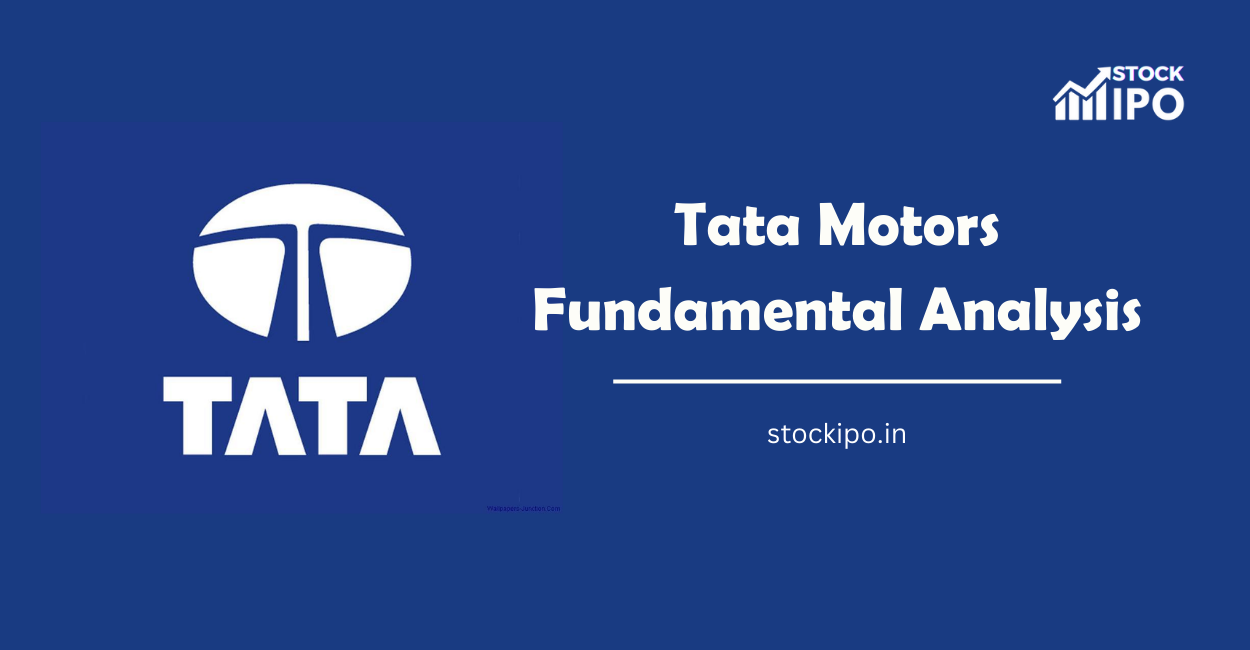Tata Motors Ltd is one of the leading automobile companies in India, manufacturing a wide range of commercial and passenger vehicles. As an investor, analyzing a company’s fundamentals is crucial before investing in its stock. In this article, we will conduct a fundamental analysis of Tata Motors Ltd and evaluate its financial performance, key drivers of growth, risk factors, management, corporate governance, and investment outlook.
Company Overview

Tata Motors Ltd was founded in 1945 and is headquartered in Mumbai, India. The company’s products include passenger cars, utility vehicles, trucks, buses, and defense vehicles. Tata Motors has a significant presence in India and operates in over 175 countries worldwide, with a market share of 38.64% in the Indian commercial vehicle market. Its key competitors include Maruti Suzuki, Mahindra & Mahindra, and Ashok Leyland. The Indian automobile industry has seen a significant shift towards electric vehicles, and Tata Motors has been actively working towards launching electric cars.
Financial Performance
Tata Motors Ltd is a large-cap company with a market capitalization of around Rs. 170,000 crore as of March 2023. The company’s enterprise value is around Rs. 239,000 crore, indicating that it has a significant amount of debt in its capital structure. The P/E ratio of Tata Motors Ltd is around 10.4, which is lower than the industry average of 14.4, indicating that the company’s earnings are undervalued by the market.
The P/B ratio of the company is around 1.3, which is also below the industry average of 1.8, suggesting that the stock may be undervalued based on its book value.

Tata Motors Ltd has a face value of Rs. 2 per share and a dividend yield of around 0.7%, indicating that the company’s dividend payout is relatively low. The company’s book value per share is around Rs. 102, indicating that the stock may be trading at a discount to its intrinsic value.
In terms of financial performance, Tata Motors Ltd has shown strong growth in recent years. The company’s EPS has grown at a CAGR of around 34.9% over the past five years, while its sales have grown at a CAGR of around 10.6% over the same period.
The company’s profit growth has also been impressive, with a CAGR of around 63.4% over the past five years. The company’s ROE and ROCE have been around 18% and 12%, respectively, indicating that the company is generating decent returns on its capital.
When compared to industry benchmarks and historical data, Tata Motors Ltd appears to be undervalued based on its P/E and P/B ratios. The company’s EPS growth and profit growth have also been strong, suggesting that the company has a solid financial foundation.
| Particulars | March 2018 | March 2019 | March 2020 | March 2021 | March 2022 | YoY Growth/Loss |
|---|---|---|---|---|---|---|
| Net Sales | 57896.53 | 69202.76 | 43928.17 | 30175.03 | 47263.68 | 0.56% |
| Total Expenditure | 55632.14 | 64269.11 | 44611.09 | 28741.31 | 45843.12 | 0.594% |
| Operating Profit | 2264.39 | 4933.65 | -682.92 | 1433.72 | 1420.56 | -0.01% |
| Other Income | 2601.67 | 2560.56 | 1414.79 | 440.64 | 738.28 | 0.671% |
| Interest | 1744.43 | 1793.57 | 1973 | 2110.83 | 2121.73 | 0.005% |
| Depreciation | 3101.89 | 3098.64 | 3375.29 | 1730.7 | 1760.57 | 0.017% |
| Exceptional Items | -966.66 | -203.07 | -2510.92 | -307.55 | 83.41 | -1.272% |
| Profit Before Tax | -946.92 | 2398.93 | -7127.34 | -2274.72 | -1640.05 | -0.28% |
| Tax | 87.93 | 378.33 | 162.29 | 20.72 | 99.18 | 3.783% |
| Net Profit | -1034.85 | 2020.6 | -7289.63 | -2395.44 | -1390.86 | -0.42% |
| Adjusted EPS (Rs.) | -3.05 | 5.95 | -20.26 | -6 | -4.54 | -0.243% |
Key Drivers of Growth and Risk Factors
The main driver of growth for Tata Motors Ltd is its automotive business, which includes passenger vehicles, commercial vehicles, and electric vehicles. The company has a strong market position in India and has been expanding its global presence in recent years. The company’s luxury car brand, Jaguar Land Rover (JLR), has also been performing well, particularly in China, which is the world’s largest automotive market.
However, there are also several risk factors that could impact the company’s growth prospects. One of the main risks is the highly competitive nature of the automotive industry, which could result in price competition and margin pressure.
Additionally, the company’s significant debt load could also be a concern, as it increases the company’s financial risk and limits its ability to invest in growth opportunities.
Management and Corporate Governance
Tata Motors Ltd is led by Chairman Natarajan Chandrasekaran and CEO Guenter Butschek. The company has a diverse and experienced board of directors, with several independent directors and women on the board. The company has also implemented various policies and procedures to ensure ethical and responsible behavior, including a code of conduct for directors and employees, and a whistle-blower policy.
Valuation and Investment Outlook
Based on its strong financial performance and growth prospects, Tata Motors Ltd appears to be undervalued relative to its peers and historical data. Analysts are generally bullish on the stock, with a consensus target price of around Rs. 500 per share, indicating significant upside potential from the current market price of around Rs. 350 per share.
However, there are also several risks to consider, including the highly competitive nature of the automotive industry and the company’s significant debt load. Additionally, macroeconomic factors such as fluctuations in commodity prices and currency exchange rates could also impact the company’s performance.
Conclusion
In conclusion, Tata Motors Ltd is a well-established automobile company with a strong global presence and a diverse range of products and services. Through a comprehensive fundamental analysis of the company’s financial performance, key drivers of growth and risk factors, management and corporate governance, and valuation and investment outlook, we have gained a deeper understanding of the company’s strengths, weaknesses, opportunities, and threats.
Despite facing some challenges in the form of the COVID-19 pandemic, supply chain disruptions, and intensifying competition in the industry, Tata Motors has demonstrated resilience and agility in adapting to changing market conditions and maintaining its position as a leading player in the automobile industry.
Based on the analysis, we believe that Tata Motors presents an attractive investment opportunity for long-term investors who are willing to tolerate some volatility and uncertainty. While the stock may experience some short-term fluctuations in response to macroeconomic and industry factors, we expect the company’s strong fundamentals, innovative products and services, and competent leadership to drive long-term growth and value creation for shareholders.







